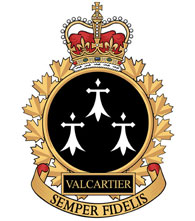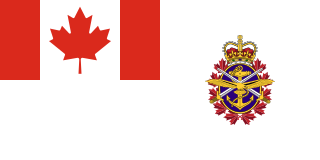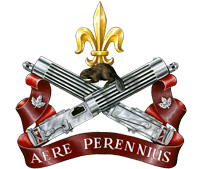
The Canadian Army is the command responsible for the operational readiness of the conventional ground forces of the Canadian Armed Forces. It maintains regular forces units at bases across Canada, and is also responsible for the Army Reserve, the largest component of the Primary Reserve. The Army is headed by the Commander of the Canadian Army and Chief of the Army Staff, who is subordinate to the Chief of the Defence Staff. The Army is also supported by 3,000 civilian employees from the public service.

The 2nd Canadian Division is a formation of the Canadian Army in the province of Quebec, Canada. The present command was created 2013 when Land Force Quebec Area was re-designated. The main unit housed in this division is the Royal 22nd Regiment based at CFB Valcartier near Quebec City, which is the largest regiment in the Canadian Army.

2nd Canadian Division Support Base Valcartier, formerly known as and commonly referred to as Canadian Forces Base Valcartier, is a Canadian Forces base located in the municipality of Saint-Gabriel-de-Valcartier, 8 nautical miles north northwest of Quebec City, Quebec, Canada. The 2nd Canadian Division is stationed at the base, comprising the 5 Canadian Mechanized Brigade Group and the 2nd Canadian Division Support Group.

The Royal 22nd Regiment is an infantry regiment of the Canadian Army. Known colloquially in English as the Van Doos or in French as le Vingt-deuxième, the mostly francophone regiment comprises three Regular Force battalions, two Primary Reserve battalions, and a band, making it the largest regiment in the Canadian Army. The headquarters of the regiment is at the Citadelle of Quebec in Quebec City, also the site of the regimental museum, and all three of its regular battalions are stationed at Canadian Forces Base Valcartier in Saint-Gabriel-de-Valcartier, 15 kilometres (9.3 mi) outside of Quebec City. The regiment is a "British-style" infantry regiment that is the spiritual home and repository of customs and traditions for a number of battalions that do not necessarily serve together operationally. It serves as the "local" infantry regiment for the province of Quebec, where it draws most of its recruits; it is the largest regiment in the province, in terms of numbers.

The following is a list of the notable authorized marches for various organisations of the Canadian Armed Forces. The first march listed is the march most commonly performed for that organisation on parade; it is commonly referred to simply as that organisation's "march" or "march past". In addition, many organisations also have additional pieces for slow marches, marches for mounted parades, pipe marches, etc.; they are subsequently listed and footnoted as applicable.

The Régiment de la Chaudière is a Primary Reserve infantry regiment of the Canadian Army. It is part of the 2nd Canadian Division's 35 Canadian Brigade Group and is headquartered at Lévis, Quebec.
This is the structure of the Canadian Army, as of August 2022.

The Communications and Electronics Branch is a personnel branch of the Canadian Armed Forces (CAF). The army component of the branch is designated the Royal Canadian Corps of Signals.
A service battalion is a unit of the Canadian Armed Forces (CAF) that provides combat service support to a brigade group and its elements.

The Primary Reserve of the Canadian Armed Forces is the first and largest of the four sub-components of the Canadian Armed Forces reserves, followed by the Supplementary Reserve, the Cadet Organizations Administration and Training Service and the Canadian Rangers.

5 Canadian Mechanized Brigade Group is a Canadian Forces brigade group that is part of 2nd Canadian Division of the Canadian Army. It is based at CFB Valcartier, near Quebec City, Quebec. The brigade group is the formation responsible for the majority of francophone units of the regular army.

The Canadian Forces Health Services Group is a formation of the Canadian Forces within the Military Personnel Command. It includes personnel from both the Royal Canadian Medical Service and the Royal Canadian Dental Corps, fulfills all military health system functions from education and clinical services to research and public health, and is composed of health professionals from over 40 occupations and specialties in over 120 units and detachments across Canada and abroad.
Canadian Forces Europe was the Canadian Forces military formation in Europe during the Cold War. The CF assisted other NATO allies in watching the military activities of Warsaw Pact and the Soviet Union.

34 Canadian Brigade Group is a Primary Reserve component of 2nd Canadian Division, under the Canadian Army. It is headquartered in Montreal, Quebec. It is the successor of the Cold War-era Montreal Militia District.
Lieutenant General Jacques Chouinard CMM CD was the Commander, Mobile Command of the Canadian Forces.
35 Combat Engineer Regiment (35CER) is a reserve unit of the Canadian Military Engineers in Quebec City, Quebec, Canada. It is part of the 35 Canadian Brigade Group, 2nd Canadian Division.

The following outline is provided as an overview of and topical guide to Quebec:

37 Canadian Brigade Group is a reserve component brigade of the Canadian Army, which supervises Militia units in 5th Canadian Division for New Brunswick and Newfoundland and Labrador. It was created by merging the New Brunswick Militia District and the Newfoundland and Labrador Militia District.
The following is a hierarchical outline for the Canadian Armed Forces at the end of the Cold War. It is intended to convey the connections and relationships between units and formations.














